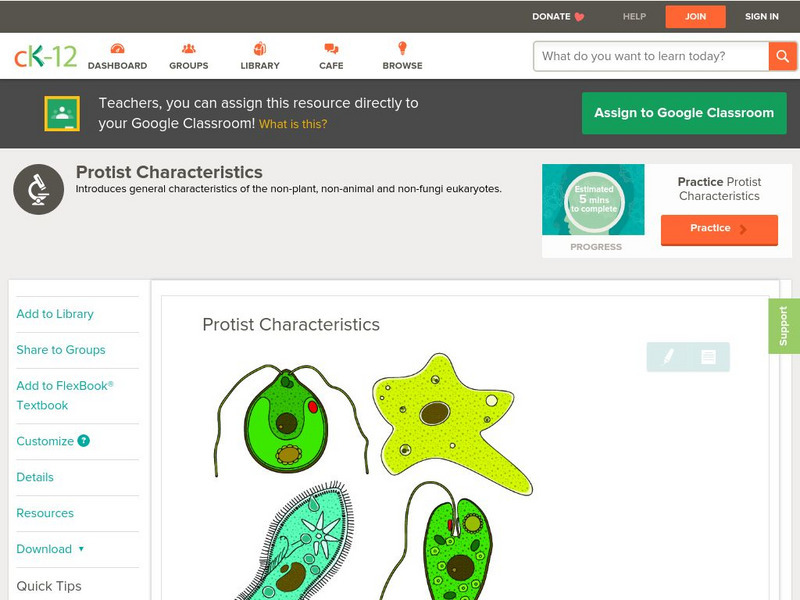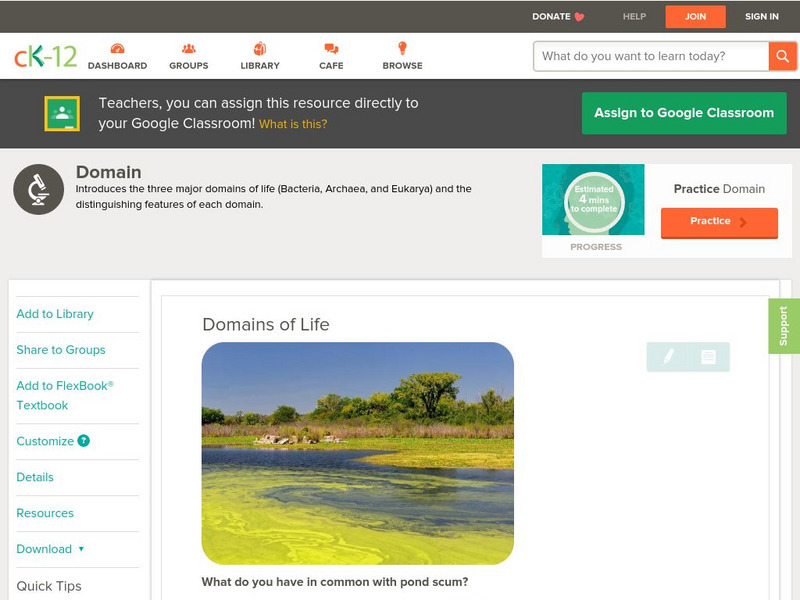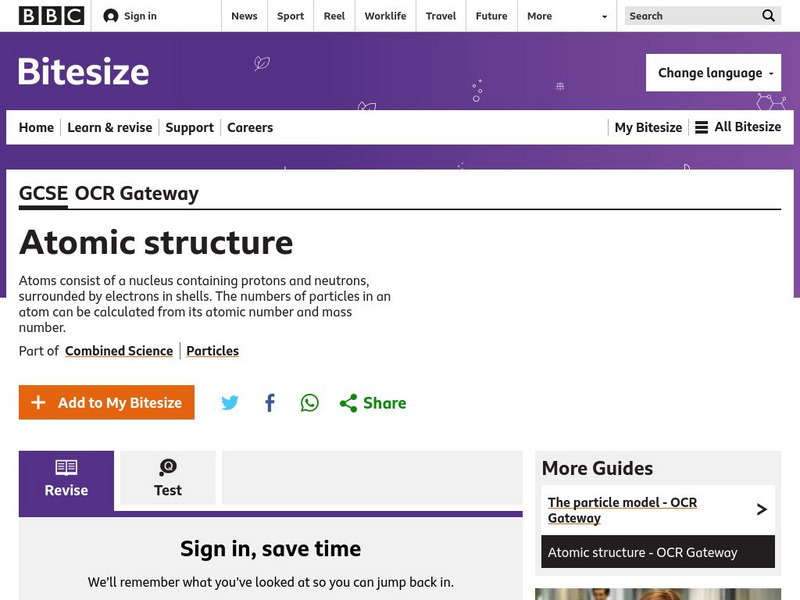Chiral Publishing
Chiral Publishing: An Introduction to Chemistry: Nuclear Chemistry [Pdf]
In Chapter 18, Nuclear Chemistry, learn about the nucleus and radioactivity, uses of radioactive substances, and nuclear energy. View different objectives that help aide the understanding of nuclear energy and radioactive emissions....
Cold Spring Harbor Laboratory
Dolan Dna Learning Center: Dna Molecule: How Dna Is Packaged Basic
See how our DNA is tightly packed up so that six feet of this long molecule fits into the microscopic nucleus of every cell. [1:30]
Energy for Sustainable Development
Esd Bulgaria: Kids & Energy: Uranium (Nuclear)
Nuclear energy is energy in the nucleus of an atom. Atoms are tiny particles that make up every object in the universe. There is enormous energy in the bonds that hold atoms together. Nuclear energy can be used to make electricity. But...
Science Education Resource Center at Carleton College
Serc: Quantum Atomic Structure
This multi-day lesson plan helps learners to understand how the models of the atom have changed and how quantum mechanics affects the electrons as they orbit the nucleus.
TED Talks
Ted: Ted Ed: The Operating System of Life
Cells are almost like tiny factories run by robots, with the nucleus, DNA, proteins, lipids, and vitamins and minerals all playing critical roles. George Zaidan and Charles Morton lay out the blueprint of a cell and explain how...
Concord Consortium
The Concord Consortium: Molecular Workbench Zoom It
See examples of scales based on a range from ten to the twelfth meters to ten to the negative twelth meters. Examples range from parts of our solar system to the nucleus of an atom.
Biology 4 kids
Biology4 Kids: Chromosomes Pull Up Those Genes
Read about how the genetic information in a cell is organized in the nucleus.
NASA
Nasa: Landing on Mystery Stuff
At this online lesson plan read about the exciting Comet Nucleus Sample Return Mission. Understand comets and then go and do the word search.
PurposeGames
Purpose Games: The Plant Cell
Take this 13 question quiz to test your knowledge of the parts of a plant cell. Know vocabulary such as nucleus, chloroplast, and ribosome.
Famous Scientists
Famous Scientists: Aage Bohr
Learn about the life of Aage Niels Bohr, and see how his work was pivotal in the development of the theory of the structure of the atomic nucleus.
CK-12 Foundation
Ck 12: Chemistry: Gold Foil Experiment: Rutherford's Atomic Model
[Free Registration/Login may be required to access all resource tools.] This site explains Rutherford's discovery of the nucleus and the planetary model of the atom and the role of gold foil experiment in refining the atomic model. It...
CK-12 Foundation
Ck 12: Life Science: Archaea
[Free Registration/Login may be required to access all resource tools.] For many years, archaea were classified as bacteria. Like the bacteria, archaea lacked a nucleus and membrane-bound organelles and, therefore, were prokaryotic...
CK-12 Foundation
Ck 12: Life Science: Protist Characteristics
[Free Registration/Login may be required to access all resource tools.] Protists are eukaryotes, which means their cells have a nucleus and other membrane-bound organelles. Most protists are single-celled. Other than these features, they...
CK-12 Foundation
Ck 12: Life Science: Domains of Life
[Free Registration/Login may be required to access all resource tools.] Humans are in the same domain as trees and algae. What could they possibly have in common? It is the location of their DNA inside their cells. Their cells all have a...
CK-12 Foundation
Ck 12: Life Science: Mitosis and Cytokinesis
[Free Registration/Login may be required to access all resource tools.] During mitosis, the DNA in a nucleus must replicate. The copied DNA is divided into two genetically identical sets, so that after cytokinesis or cell division, each...
CK-12 Foundation
Ck 12: Life Science: Translation of Rna to Protein
[Free Registration/Login may be required to access all resource tools.] The mRNA, which is transcribed from the DNA in the nucleus, carries the directions for the protein-making process. mRNA tells the ribosome how to create a specific...
Chem4kids
Chem4 Kids: Atoms: Neutrons
Students will find an explanation of the neutron particle located inside the atom's nucleus. Website also defines isotopes and the process of radioactive decay.
Chem4kids
Chem4 Kids: Atoms: Orbitals
The website provides an explanation of the electrons' position in their orbitals as they spin around the nucleus. Quantum theory is also explored by explaining that the exact location of a specific electron is a not exact but a guess.
Cold Spring Harbor Laboratory
Dna From the Beginning: Dna and Proteins
Explore the convept that DNA and proteins are key molecules of the cell nucleus.
Other
Society for General Microbiology: Bacteria
Bacteria are single celled microbes. The cell structure is simpler than that of other organisms as there is no nucleus or membrane bound organelles. Instead their control centre containing the genetic information is contained in a single...
BBC
Bbc: Gcse Bitesize: Atomic Structure
This lesson focuses on the structure of atoms. All substances are made from atoms. Each atom is made of a nucleus - containing protons and neutrons - surrounded by electrons. It provides a link to an assessment.
BBC
Bbc: Gcse Bitesize: What Does the Periodic Table Tell Us About the Elements?
The number of protons in the atom of an element determines its place in the Periodic Table. The number of electrons in an atom is the same as the number of protons. These electrons are arranged in shells or 'energy levels' around the...
CK-12 Foundation
Ck 12: Life Science: Prokaryotic and Eukaryotic Cells
[Free Registration/Login may be required to access all resource tools.] There are two basic types of cells, prokaryotic cells and eukaryotic cells. The main difference between eukaryotic and prokaryotic cells is that eukaryotic cells...
Davidson College
Davidson College: Effective Nuclear Charge
Explains what the effective nuclear charge is and how electrons can create a shield between a nucleus and an outer electron. Presents exercises for comparing orbital sizes with effective nuclear charges. Requires Java.
Other popular searches
- Cell Nucleus
- Atomic Nucleus
- Comet Nucleus
- Nucleus Dna Replication
- Nucleus of Cells
- The Nucleus
- Nucleus Radioactivity
- Condensation Nucleus
- Nucleus Discovery
- Chromatin Nucleus
- Nucleus and Human Body
- Nucleus Partners
![Chiral Publishing: An Introduction to Chemistry: Nuclear Chemistry [Pdf] eBook Chiral Publishing: An Introduction to Chemistry: Nuclear Chemistry [Pdf] eBook](https://d15y2dacu3jp90.cloudfront.net/images/attachment_defaults/resource/large/FPO-knovation.png)




















